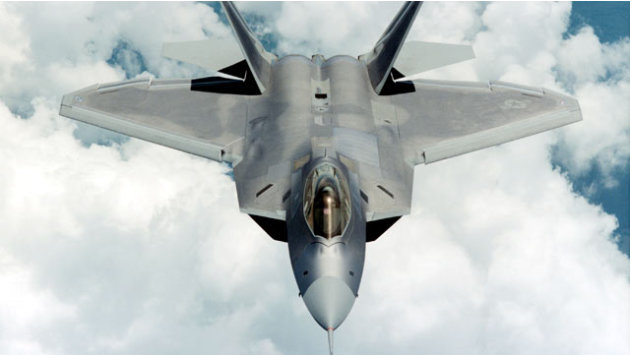
The United States has spent nearly $80 billion to develop the most advanced stealth fighter jet in history, the F-22 Raptor, but the Air Force recently found out firsthand that while the planes own the skies at modern long-range air combat, it is "evenly matched" with cheaper, foreign jets when it comes to old-school dogfighting.
The F-22 made its debut at the international Red Flag Alaska training exercise this June where the planes "cleared the skies of simulated enemy forces and provided security for Australian, German, Japanese, Polish and [NATO] aircraft," according to an after-action public report by the Air Force. The F-22 took part in the exercise while under strict flying restrictions imposed by Defense Secretary Leon Panetta in light of mysterious, potentially deadly oxygen problems with the planes - problems that the Pentagon believes it has since solved.
The Air Force said the planes flew 80 missions during the event "with a very high mission success rate." However, a new report from Combat Aircraft Monthly revealed that in a handful of missions designed to test the F-22 in a very specific situation - close-range, one-on-one combat - the jet appeared to lose its pricey advantages over a friendly rival, the Eurofighter Typhoon, flown in this case by German airmen.
"We expected to perform less with the Eurofighter but we didn't," German air officer Marc Grune said, according to Combat Aircraft Monthly. "We were evenly matched. They didn't expect us to turn so aggressively."
Two other German officers, Col. Andreas Pfeiffer and Maj. Marco Gumbrecht, noted in the same report that the F-22's capabilities are "overwhelming" when it comes to modern, long-range combat as the stealth fighter is designed to engage multiple enemies well-beyond the pilot's natural field of vision - mostly while the F-22 is still out of the other plane's range. Grumbrecht said that even if his planes did everything right, they weren't able to get within 20 miles of the next-generation jets before being targeted.
"But as soon as you get to the merge…" Pfeiffer said, referring to the point at which fighters engage in close-up dog fighting, "in that area, at least, the Typhoon doesn't necessarily have to fear the F-22 in all aspects… In the dogfight the Eurofighter is at least as capable as the F-22, with advantages in some aspects."
In response to the report, a spokesperson for the Air Force, Lt. Col. Tadd Sholtis, told ABC News that one-on-one combat is only one way to evaluate an aircraft's capabilities and said it's not "necessarily the most relevant to every scenario."
"The F-22 is conceived and employed as part of an integrated force that provides offensive capabilities that make close engagements far less likely while retaining the ability to handle close engagements in tandem with other fighters," he said.
Air Force Gen. John Jumper, one of the few airmen to have flown both aircraft, said in 2005 that it is difficult to compare the F-22 and the Eurofighter.
"They are different kinds of airplanes to start with," he said, according to an Air Force Print News report. "It's like asking us to compare a NASCAR car with a Formula 1 car. They are both exciting in different ways, but they are designed for different levels of performance."
The F-22 "can maneuver with the best of them if it has to, but what you want to be able to do is get into contested airspace no matter where it is," Jumper said, referring to the F-22's stealth and supercruise capabilities that are meant to allow the plane to sneak in to hostile territory undetected - an ability the non-stealth Eurofighter lacks.
As for where that contested airspace may be, the Air Force hasn't said. But in April 2011 an executive for Lockheed Martin, the primary manufacturer of the F-22, told ABC News that the plane could "absolutely" find a home in quick strike missions against countries like Iran or North Korea. Over the weekend, the Air Force deployed a squadron of F-22s to Kadena Air Base in southern Japan just over 800 miles south of the North Korean border - a move that comes three months after an undisclosed number of the stealth jets were deployed to an allied base in the United Arab Emirates, some 200 miles from the Iranian mainland.
The F-22 is the single most expensive fighter jet in history at a total acquisition cost of an estimated $79 billion for 187 planes, meaning each plane costs approximately $420 million. Estimates for the Eurofighter Typhoon - the premier fighter for several allied countries including the U.K., Germany and Italy - put that plane at just under $200 million each, according to an April 2011 report by England's Public Accounts Committee.
"[Red Flag was] a mission to get to know each other, the first contact by German Eurofighters in the continental U.S.," Grune said of mock-fighting the F-22s. "We are not planning on facing each other in combat. We want to work together but it was a starter for us to work together. They were impressed, as we were impressed by them."
Also Read
No comments:
Post a Comment